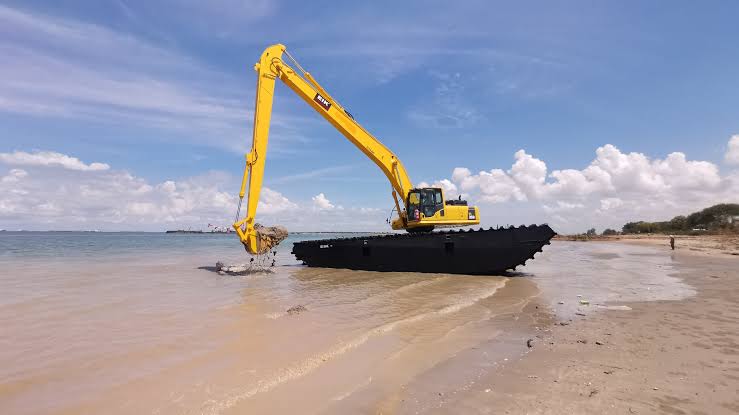Diving into the Depths: Unveiling the Secrets of Amphibious Excavators

When it comes to tackling waterlogged terrains and underwater excavations, few machines are as versatile and essential as amphibious excavators. Let’s explore what amphibious excavators are, how they work, and which excavator is best suited for underwater digging.
Contents
What is an Amphibious Excavator?
An amphibious excavator is a specialized piece of heavy machinery designed to operate in waterlogged environments. Unlike standard excavators that struggle in marshes, swamps, or shallow waters, amphibious excavators are built to navigate such terrains effortlessly. They are equipped with extended undercarriages that feature wide, buoyant tracks or pontoons, allowing them to float on water and provide stability while working in aquatic environments.
What is Amphibious Equipment?
Amphibious equipment, like amphibious excavators, is a category of machinery designed to function both on land and in water. These versatile machines are indispensable in various industries, including construction, environmental conservation, dredging, and disaster response. They offer the advantage of accessing remote or challenging locations, such as wetlands and riverbeds, while minimizing environmental impact.
How Do Underwater Excavators Work?
Amphibious excavators rely on their specialized undercarriages to work in aquatic environments. Here’s how they operate:
Buoyant Undercarriage: The key feature of amphibious excavators is their buoyant undercarriage, which keeps the machine afloat while distributing its weight evenly. This design prevents the excavator from sinking into soft mud or water.
Wide Tracks or Pontoons: The wide tracks or pontoons provide stability on water and ensure minimal ground pressure when operating in wetlands. This prevents damage to sensitive ecosystems.
Hydraulic Attachments: Like standard excavators, amphibious excavators are equipped with hydraulic attachments such as buckets or grapples. Operators use these attachments to perform various tasks, including dredging, digging, and debris removal.
Amphibious Excavator Manufacturers
A diverse range of manufacturers produces amphibious excavators, each with its own innovative designs and specializations. These manufacturers prioritize durability, performance, and environmental consciousness in their designs, ensuring that customers receive machinery capable of enduring the toughest conditions while leaving minimal impact on fragile ecosystems.
As the demand for amphibious excavators continues to grow across industries, these manufacturers play a pivotal role in advancing the technology and versatility of these remarkable machines, making them indispensable tools for tackling aquatic challenges worldwide.
Which Excavator is Most Suitable for Digging Underwater?
When it comes to underwater excavations, amphibious excavators are the clear choice. Their specialized design and buoyant undercarriages make them the most suitable option for working in wetlands, swamps, rivers, and shallow coastal areas. They not only ensure the safety of the operator and equipment but also protect the delicate aquatic ecosystems.
Applications of Amphibious Excavators
Construction and Infrastructure Development
In the construction industry, especially in regions with extensive water bodies, amphibious excavators are indispensable. They are used for tasks such as dredging lakes and rivers to create stable foundations for bridges and buildings, constructing embankments, and maintaining waterways. Their adaptability ensures that projects stay on track even when water becomes an obstacle.
Disaster Response and Flood Control
During natural disasters like floods or hurricanes, amphibious excavators play a critical role in disaster response efforts. They can swiftly clear debris, open blocked water channels, and reinforce levees or dams. Their ability to access flooded areas is a game-changer when time is of the essence in mitigating damage and providing aid.
Marine and Port Operations
Amphibious excavators are also used in marine and port operations. They can efficiently dredge harbors and waterways, maintaining proper depths for ships to navigate safely. Additionally, they are valuable for cleaning up and maintaining ports and coastal areas.
Environmental Conservation and Wetland Restoration
One of the most crucial applications of amphibious excavators is in environmental conservation and wetland restoration. Wetlands are vital ecosystems that provide habitat for diverse plant and animal species while also serving as natural buffers against floods. Amphibious excavators allow experts to conduct necessary maintenance and restoration work in these areas without causing harm to the delicate surroundings.
Conclusion
Amphibious excavators are the unsung heroes of the heavy machinery world, bridging the gap between land and water. Their ability to navigate and perform underwater excavations in challenging environments makes them indispensable in various industries. Whether it’s construction, environmental conservation, or disaster response, amphibious excavators are the go-to machines for jobs that require precision, power, and versatility in the wettest of places.
FAQ’S
1: What Are the Benefits of Amphibious Excavators?
Amphibious excavators excel in wetland work, thanks to their low ground pressure, wide tracks, and versatility. They’re ideal for construction, conservation, and disaster response.
2: How Do I Choose the Right Amphibious Excavator?
Select the best amphibious excavator by considering your project’s requirements, water depth, and size needs. Consult with experts for guidance.
3: What’s the Maintenance Routine for Amphibious Excavators?
Maintaining amphibious excavators involves regular cleaning, hydraulic system checks, lubrication, engine maintenance, and safety feature inspections. Proper upkeep ensures safe and efficient operation in aquatic environments.




